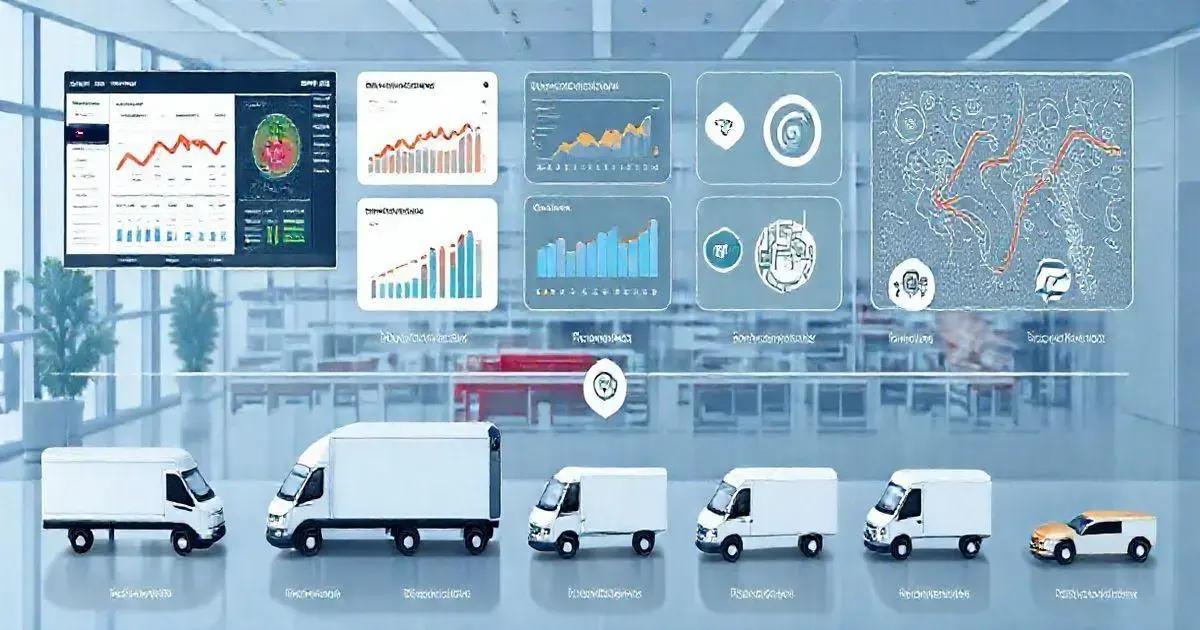Top 5 Features of Fleet Control Worksheet 7.0 You Need Leave a comment
The Fleet Control Worksheet 7.0 is a vital tool for fleet management, providing features for driver and vehicle registration, travel tracking, and maintenance oversight. It allows managers to analyze yearly data on travel, maintenance costs, and fuel consumption, leading to improved resource management, enhanced safety, and cost savings, ultimately supporting better decision-making in fleet operations.
The Fleet Control Worksheet 7.0 is designed to streamline logistics management with robust features tailored for effective vehicle tracking and maintenance.
This comprehensive tool allows you to keep a close eye on your fleet’s performance, ensuring that every vehicle is operating efficiently and safely. In this article, we’ll delve into the top features of this powerful worksheet and how it can make a significant difference in your operational efficiency.
Initial Dashboards Overview
The Initial Dashboards in the Fleet Control Worksheet 7.0 provide crucial insights at a glance, allowing fleet managers to monitor various metrics effectively. Here’s a breakdown of the key components you’ll find:
1. KM by Driver: This metric tracks the total kilometers driven by each driver. It helps in identifying top performers and those who may need additional training or support.
2. KM per Vehicle: Similar to the previous metric, this tracks the distance each vehicle covers. Understanding usage can help in scheduling maintenance and determining vehicle efficiency.
3. KM per Liter: This important figure gives insight into the fuel efficiency of your fleet. By monitoring KM per liter, you can identify vehicles that may require maintenance or adjustments to improve fuel consumption.
4. KM per Trip: This metric averages the kilometers traveled per trip, helping to evaluate routes and optimize logistics. It can highlight trips that may be longer than necessary, allowing for route adjustments.
5. Average Consumption per Vehicle: This gives you a clear picture of how much fuel each vehicle typically uses, enabling you to benchmark performance across your fleet.
6. Average Consumption per Driver: Similar to vehicle consumption, but focused on driver performance. This can help you identify inconsistencies in driving habits.
7. Total General Maintenance: Keeping track of all types of maintenance performed on the fleet is essential for planning future service and ensuring vehicles remain in good working condition.
8. Maintenance Cost Average: By averaging the costs associated with maintenance, you can better budget for future expenses and make cost-saving decisions.
9. Total Cost of Mechanical and Electrical Maintenance: This metric consolidates all costs related to mechanical and electrical repairs, giving a comprehensive view of ongoing expenses.
10. Total Tire Maintenance Cost: Tire management is crucial for safety and efficiency. This figure helps you keep track of expenses related to tire replacements and maintenance.
11. Total Lubricant Cost: Monitoring lubricant costs enables you to ensure proper maintenance practices are followed, which is key for vehicle longevity.
12. Average Cost by Maintenance Type: With average costs tracked by different maintenance types, you can pinpoint areas where you might optimize spending.
13. Delayed Vehicle and Driver Documentation: Keeping an eye on documentation helps prevent legal issues and ensures vehicles and drivers meet all regulatory requirements.
14. Fuel, Maintenance, and Other Costs: This aggregated view provides a holistic approach to managing your fleet’s financial health, enabling better decision-making.
These dashboards offer a powerful starting point to manage your fleet effectively, ensuring that you have all the necessary data at your fingertips to make informed decisions.

Comprehensive Registrations
The Comprehensive Registrations section of the Fleet Control Worksheet 7.0 is designed to keep all essential information organized and easily accessible, making it a vital component for effective fleet management. This section encompasses various types of registrations that enhance monitoring and compliance across your fleet:
1. Driver Registration: This includes detailed profiles for each driver, capturing personal information, licensing details, and contact information. Keeping this data updated is crucial for ensuring that all drivers are qualified and compliant with regulations.
2. Vehicle Type Registration: Categorizing vehicles by type (e.g., vans, trucks, etc.) helps in analyzing performance metrics specific to each class, facilitating targeted maintenance and operational strategies.
3. Mechanical and Electrical Services Registry: Documenting all mechanical and electrical services performed on the vehicles ensures that you have an accurate history of repairs and maintenance, which is essential for tracking the reliability and longevity of each vehicle.
4. Tree Service Registration: This feature allows for detailed tracking of various tree services associated with fleet operations, from routine checks to specialized maintenance tasks.
5. Lubricant Services Register: Keeping a log of lubricant services helps manage and monitor the upkeep of each vehicle’s engine performance, ensuring that all necessary lubrication tasks are completed on schedule.
6. Register of Workshops and Suppliers: This registry provides a comprehensive list of trusted workshops and suppliers, streamlining the process of sourcing parts and services while ensuring quality and compliance standards are met.
7. Expenditure Type Register: Categorizing expenditures by type helps in analyzing spending patterns and identifying areas for cost reduction. This can include fuel, maintenance, and operational costs.
8. Refueling Station Registration: Keeping a record of preferred refueling stations aids in ensuring that drivers have access to reliable fuel sources, which can help in reducing fuel theft and optimizing fuel management.
9. Fuel Type Register: Documenting the types of fuel used across the fleet enables better tracking of fuel expenses and can inform future purchasing decisions based on fuel efficiency and cost.
By maintaining these registrations, fleet managers can enhance operational efficiency, ensure compliance with regulations, and make informed decisions based on comprehensive data. This section not only simplifies record-keeping but also boosts accountability among drivers and maintenance personnel.
Document Management Features
The Document Management Features in the Fleet Control Worksheet 7.0 play a crucial role in ensuring that all necessary documentation related to your fleet is organized, up to date, and easily accessible. This feature not only helps in maintaining compliance but also supports smooth operational processes. Here’s a closer look at the key aspects of document management:
Driver Document Control: This feature allows you to keep track of all documents related to your drivers. This includes licenses, certifications, and any required training documentation. By maintaining a centralized record, you can ensure that all drivers are compliant with legal requirements and safety standards.
Vehicle Document Control: Similar to driver documents, this function helps manage all vehicle-related paperwork, such as registration, insurance, and inspection certificates. Keeping these documents organized helps avoid penalties and ensures that all vehicles are legally compliant for operation.
Alerts for Expiring Documents: The worksheet includes automated alerts to remind fleet managers about upcoming expiration dates for driver licenses, vehicle registrations, and other critical documents. This proactive approach minimizes the risk of lapses in documentation and helps maintain legal compliance.
Storage of Electronic Copies: The ability to store electronic copies of important documents directly within the worksheet allows for easy access and retrieval. This digital storage helps reduce paper usage and enhances efficiency when documents are needed for audits or inspections.
Access Control and Permissions: To safeguard sensitive information, the worksheet can include access controls, ensuring that only authorized personnel can view or edit specific documents. This feature is essential for maintaining confidentiality and security within your fleet management operations.
Document Versioning: Keeping track of different versions of documents ensures that you have the most current information at all times. This can be particularly important for policies and procedures that may change frequently.
Reporting and Compliance Checks: The document management system can generate reports to help you conduct compliance checks and audits. This reporting feature provides insights into document status and helps ensure that all required paperwork is in order.
By effectively utilizing these document management features, fleet managers can not only ensure compliance with industry regulations but also streamline communication and operational efficiency within the fleet. This organized approach to documentation lays the groundwork for a responsible and responsive fleet management system.

Travel Control Mechanisms
The Travel Control Mechanisms in the Fleet Control Worksheet 7.0 are essential for optimizing logistics and ensuring that every aspect of fleet travel is carefully monitored and managed. These mechanisms are designed to enhance operational efficiency, reduce costs, and improve accountability. Here’s an overview of the key features:
Cargo Control Linked to Trips: This feature allows for real-time tracking of cargo associated with each trip. By linking cargo details to specific journeys, fleet managers can monitor load accuracy, ensure timely deliveries, and manage inventory more effectively.
Vehicle Control: Keeping tabs on which vehicles are assigned to specific trips is crucial for efficient fleet operation. This mechanism ensures that each vehicle is utilized optimally, reducing idle times and enhancing overall productivity.
Driver Control: Monitoring driver assignments and performance during trips helps in identifying patterns of behavior and areas for improvement. By evaluating each driver’s performance data, you can ensure that safety protocols are followed and best practices are maintained.
Supply Control: This mechanism tracks the necessary supplies required for each trip, such as fuel, lubricants, and emergency kits. By managing supplies effectively, fleet managers can avoid shortages and ensure that vehicles are always ready for operation.
Control of All Travel Expenses: The worksheet allows for detailed tracking of all expenses associated with each trip, including fuel costs, tolls, and maintenance incurred during travel. Monitoring these expenses helps in identifying trends and making informed budgeting decisions.
Route Optimization: By analyzing travel data, the worksheet can help identify the most efficient routes for your fleet. This not only saves time but also reduces fuel consumption and wear and tear on vehicles.
Reporting and Analytics: The travel control mechanisms provide comprehensive reporting features that allow fleet managers to analyze travel patterns, costs, and driver performance. These insights are vital for strategic planning and operational adjustments.
Compliance with Regulations: Keeping track of travel-related documentation and ensuring compliance with transportation regulations is a significant feature. This includes monitoring hours of service for drivers and ensuring that all trips adhere to legal standards.
By implementing these travel control mechanisms, fleet managers can gain better visibility into operations, enhance compliance, and ultimately drive significant cost savings. The comprehensive approach to monitoring travel ensures that your fleet is not only efficient but also operates within the best practices of the industry.
Maintenance Control Insights
The Maintenance Control Insights section in the Fleet Control Worksheet 7.0 is pivotal for ensuring the longevity and reliability of your fleet. By tracking various maintenance activities, fleet managers can make informed decisions that keep vehicles in peak condition. Here’s a breakdown of the essential features included:
1. Corrective and Preventive Maintenance Types: This feature categorizes maintenance activities into corrective (repairs after a fault occurs) and preventive (scheduled maintenance to prevent issues). Understanding the balance between these types is critical for maintaining vehicle reliability and reducing downtime.
2. Maintenance by Vehicle: Tracking maintenance records for each individual vehicle allows for targeted insights. This enables fleet managers to identify which vehicles require more frequent repairs and may need to be replaced or retired sooner.
3. Maintenance by Mechanical and Electrical Type: Categorizing maintenance tasks based on mechanical and electrical needs provides clarity. This information helps in scheduling specialized services and ensuring that qualified technicians address specific issues.
4. Maintenance Costs: Keeping a detailed record of all maintenance expenses helps in budgeting and financial planning. By analyzing these costs, fleet managers can pinpoint areas where expenditures can be reduced or streamlined.
5. Preventive Maintenance Schedule: Establishing a schedule for preventive maintenance activities ensures that vehicles receive timely services. This proactive approach minimizes the risk of unexpected breakdowns and extends the lifespan of the fleet.
6. Preventive Maintenance Alerts: Automated alerts for upcoming preventive maintenance tasks help fleet managers stay on top of service schedules. This feature reduces the likelihood of missed service appointments and ensures compliance with manufacturers’ recommendations.
7. Status Tracking by Scheduled, Accomplished, and Delayed: This tracking mechanism allows fleet managers to monitor the status of maintenance tasks. It provides visibility into which tasks are on schedule, completed, or overdue, enabling effective follow-up actions.
8. Analysis by Year, Board, and Driver: Detailed analytics provide insights into maintenance patterns over time. This feature helps in identifying trends related to vehicle usage and maintenance frequency, allowing for more strategic fleet planning.
By leveraging these maintenance control insights, fleet managers can enhance vehicle performance, ensure safety, and significantly reduce operational costs. This comprehensive focus on maintenance not only protects your investment in vehicles but also improves service reliability, leading to higher customer satisfaction.
![]()
Yearly Analysis and Vehicle Life Tracking
The Yearly Analysis and Vehicle Life Tracking feature in the Fleet Control Worksheet 7.0 serves as a vital tool for fleet managers who aim to maximize the performance and lifespan of their vehicles. This section focuses on analyzing critical data over time to support informed decision-making regarding maintenance and vehicle replacement. Here’s what you can expect:
Total Travel: Tracking the total distance traveled by each vehicle provides insights into usage patterns. This data is crucial for assessing when a vehicle may need replacement based on mileage and operational demands.
Cost with Preventive and Corrective Maintenance: By analyzing maintenance costs over the year, fleet managers can evaluate the financial impact of both preventive and corrective measures. This helps in determining the total cost of ownership for each vehicle.
Fuel Consumption: Monitoring fuel consumption across the fleet allows managers to identify vehicles that may be underperforming in fuel efficiency. This data can inform decisions about re-routing, driver training, or vehicle upgrades.
Fuel Cost: Keeping tabs on fuel costs year-over-year aids in budget forecasting and helps identify trends in spending, which is essential for fleet budgeting and cost management.
KM Run: Total kilometers run by each vehicle contributes to understanding the wear and tear experienced throughout the year. This metric is essential for making timely maintenance decisions and planning for vehicle replacements.
Average KM per Liter: By calculating the average kilometers driven per liter of fuel, fleet managers can assess the overall fuel efficiency of their fleet. This insight is valuable for optimizing routes and reducing costs.
KM per Maintenance: This figure helps in evaluating how often each vehicle requires maintenance based on distance traveled. Identifying patterns can aid in scheduling preventive maintenance and planning for vehicle replacements.
Total Cost: An overview of the total costs associated with each vehicle, including maintenance, fuel, and other operational expenses, supports comprehensive financial analysis and strategic decision-making regarding fleet management.
Full Shipping Overview: This summary provides a holistic view of all operational costs tied to shipping activities, linking financial performance with travel and maintenance data.
Utilizing the Yearly Analysis and Vehicle Life Tracking feature enables fleet managers to have a complete understanding of their fleet’s performance. This data-driven approach empowers more effective planning, helping to extend vehicle life, enhance service reliability, and ultimately improve overall fleet efficiency.
Conclusion
In conclusion, the Fleet Control Worksheet 7.0 is an invaluable tool for fleet management that streamlines operations and enhances overall efficiency.
With features like comprehensive registrations, travel control mechanisms, and maintenance control insights, it provides a holistic approach to managing vehicles and drivers effectively.
The ability to analyze data yearly ensures that fleet managers can make informed decisions regarding vehicle maintenance, replacements, and operational costs.
By leveraging these insights, organizations not only optimize their fleet’s performance but also enhance safety and compliance with industry regulations.
Ultimately, investing in the Fleet Control Worksheet 7.0 translates to improved resource management and cost savings, positioning your fleet for success in an increasingly competitive market.
FAQ – Frequently Asked Questions about Fleet Control Worksheet 7.0
What is the Fleet Control Worksheet 7.0 used for?
The Fleet Control Worksheet 7.0 is designed to help fleet managers track and manage vehicle performance, maintenance, travel control, and overall logistics efficiently.
How can the worksheet help with maintenance scheduling?
The worksheet includes features for preventive and corrective maintenance tracking, automated alerts for upcoming maintenance tasks, and detailed records to assist in scheduling maintenance effectively.
Is the Fleet Control Worksheet 7.0 compatible with all versions of Excel?
Yes, the worksheet is compatible with all versions of Excel, including Excel 2007, 2010, 2013, and 2016, and works on Windows operating systems.
Can I track fuel consumption using this worksheet?
Absolutely! The worksheet allows for comprehensive tracking of fuel consumption, costs, and efficiency metrics, enabling fleet managers to optimize fuel use.
Does the worksheet provide reporting features?
Yes, the Fleet Control Worksheet 7.0 includes robust reporting features that allow fleet managers to analyze data regarding travel, maintenance costs, and vehicle performance over time.
Is technical support available if I have issues with the worksheet?
Yes, technical assistance is provided free of charge from Monday to Friday during business hours via email or WhatsApp, ensuring you can get help when needed.

